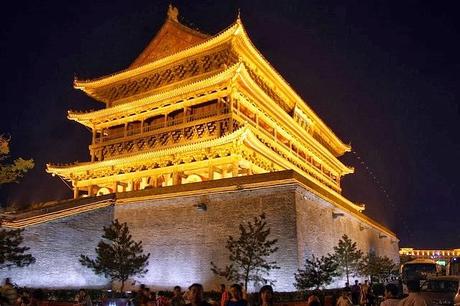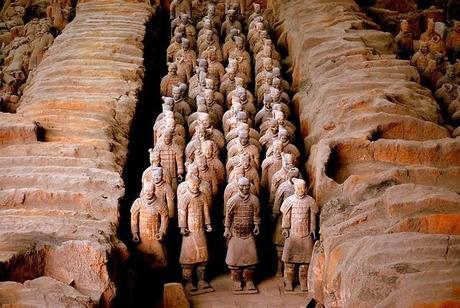
The minute I arrived, I knew I was not going to spend even a single minute at the hostel and I would be exploring the city, making the most of my time. Straight from the Xian Railway Station I jumped on the bus number 306 / 5 (money – saver trick) which wasn't fully packed (I guess I was lucky). The ride took roughly 1 hour but you will be passing by the pyramid-shaped tomb of Qin Shi Huang (be smart and investigate his contribution to the unification of China or read the post until the end). Finally, I arrived at the main culprit for my hassle – the last bus stop: Terracotta Warriors Museum.
Beware, from the entrance to the actual halls there is a 1000-metre distance and the more lazy individuals can use a tourist tram for 5 RMB. Gently, forcing you to spend some more Yuans.
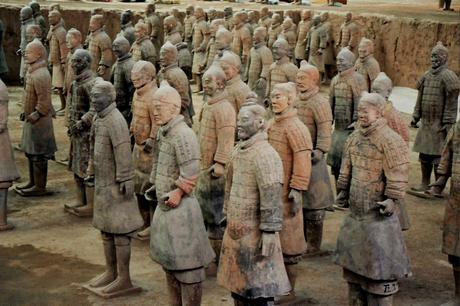 The first two halls were a kind of interesting but not truly mind altering experience. I thought to myself “so thaaat was it – not a big deal” then I realized I had missed the third hall.... which in fact was the one indicated on every website and leaflet. In these moments you would feel small and humble let’s be honest: it is not by chance that they use to say this archaeological site is one of the wonders of the world. The awkward feeling I had at that moment was due to the fact that all the warriors were staring in the same direction where I was standing. Speechless and determined, with their eyes cutting the air, protecting their ruler for the whole eternity.
The first two halls were a kind of interesting but not truly mind altering experience. I thought to myself “so thaaat was it – not a big deal” then I realized I had missed the third hall.... which in fact was the one indicated on every website and leaflet. In these moments you would feel small and humble let’s be honest: it is not by chance that they use to say this archaeological site is one of the wonders of the world. The awkward feeling I had at that moment was due to the fact that all the warriors were staring in the same direction where I was standing. Speechless and determined, with their eyes cutting the air, protecting their ruler for the whole eternity. Cultural Note Qin Shi Huang (260–210 BC) is the unifier of the Chinese empire and although cruel and vicious (up to this day this is the notion among the common people because he persecuted the scholars) he accomplished the tough task to gather the tribes and introduce standards of the written language.
And unless you are ready to bargain, avoid the pricey souvenir shops in proximity. Why? See this.
Back in the city center there are several attractions for you can discover:
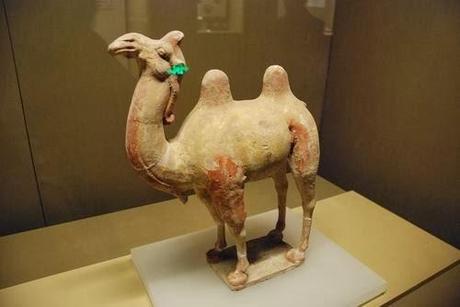 Shaanxi museum (free) – Silk Road artefacts and educational videos.
Shaanxi museum (free) – Silk Road artefacts and educational videos. Banpo Neolithic Village - This museum is to be found in an industrial area full of blue collar workers and sandy roads. The patterns of the paintings on the pottery onsite were designed from one of the first habitants of this region. The time frame of the proto script symbols, exhibited is 4500-3750 BC.
Wild goose pagoda - A funny fact is that the McDonald's building nearby had the same characteristics as the traditional Chinese architecture.
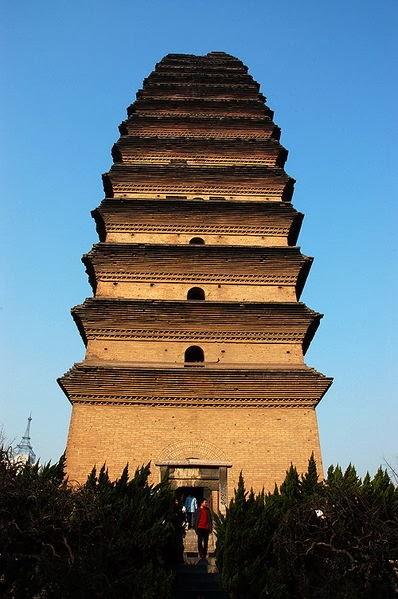 Although, making comparisons is purely subjective, I would definitely say Xian is offering much more in terms of ancient history than Beijing. I don’t know about you but I am fond of its atmosphere and unique ruins of times immemorial. The central area of the ancient capital of China is surrounded by walls and towers and thus the street planning is pretty straightforward.
Although, making comparisons is purely subjective, I would definitely say Xian is offering much more in terms of ancient history than Beijing. I don’t know about you but I am fond of its atmosphere and unique ruins of times immemorial. The central area of the ancient capital of China is surrounded by walls and towers and thus the street planning is pretty straightforward. One of the advantages of being in a hostel is that you can enjoy the proximity of the central attractions. For example I was woken up by the amazing sound of the Bell Tower (it kind of reminded me of the catholic version) and there was a great variety of snacks waiting for me outside (veggie bao zi , fried mushrooms and dou jiang). Tai Chi masters advertised classes on notice boards, however, 2 days won’t make you a master.
I met a couple of Americans that were about to visit Huashan mountain, and I felt pity because my schedule was very tight. Therefore I had to sacrifice the hiking for the local attractions.
Xian vs Beijing: 2:1
